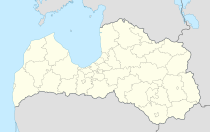Līksna
| Līksna ( German : Lixna) | ||
|---|---|---|
 Help on coat of arms |
|
|
| Basic data | ||
| State : |
|
|
| Landscape: | Latgale ( Latvian : Latgale ) | |
| Administrative district : | Daugavpils novads | |
| Coordinates : | 55 ° 59 ' N , 26 ° 23' E | |
| Residents : | 213 (Jun 3, 2015) | |
| Area : | ||
| Population density : | ||
| Height : | ||
| Website: | www.liksna.lv | |
| Post Code: | ||
| ISO code: | ||
Līksna (German: Lixna, Lixten) is a village in southeastern Latvia .
Līksna is located about 15 km northwest of the city of Daugavpils , near the Daugava River and the A6 state road . In 2010 the town and the surrounding community had 1295 inhabitants.
history
In 1770 the buildings of the Lixna estate were rebuilt in the baroque style and provided with a spacious park. The library of the Līksna Castle had 20,000 books. Līksna was a center of spiritual life in Latgale.
In the First World War, these buildings were destroyed.
Personalities
- Eduard von der Ropp (1851–1939, born in Lixna), Catholic archbishop in Russia and Lithuania
- Emilia Plater (1806–1831), known as the “Lithuanian-Polish Joan of Arc”, spent her youth in Lixna
- Noble family Plater - Syberg
literature
- Astrīda Iltnere (ed.): Latvijas Pagasti, Enciklopēdija. Preses Nams, Riga 2002, ISBN 9984-00-436-8 .
Individual evidence
- ↑ Līksnas muiža ( Memento of the original from March 4, 2016 in the Internet Archive ) Info: The archive link was inserted automatically and has not yet been checked. Please check the original and archive link according to the instructions and then remove this notice. (Latvian)
- ^ Homepage of the community, accessed on October 19, 2012
- ↑ Olga Jesse: German nobility in Latgale . In: Ilze Krokša, Aina Balaško (ed.): Vācu kultūra Latvijā. Ieskats vācu-latviešu novadu kultūras un vācu biedrību vēsturē = German culture in Latvia. Insight into the history of the German-Latvian regional cultures and the German club history . Latvijas Vācu Savienība, Riga 2009, ISBN 978-9984-39-832-7 , p. 41.

